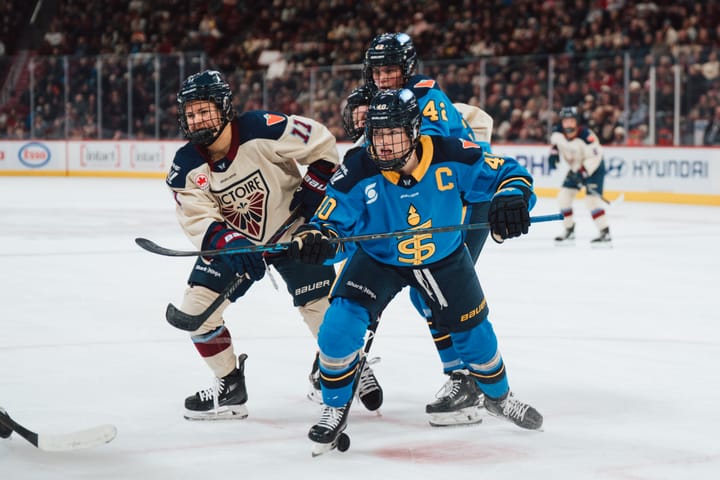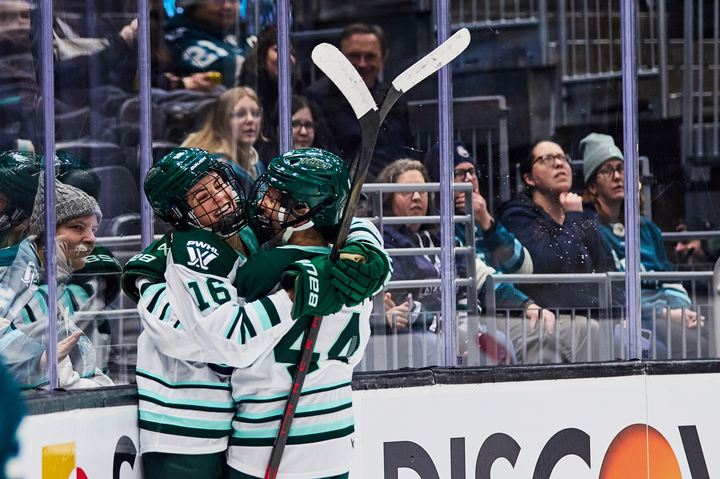Breaking down Team Canada’s 2021-22 centralization roster
Hockey Canada named the 28 players who will centralize ahead of the 2022 Olympics
Team Canada announced the 28 players that will centralize for the 2021-22 season ahead of the Winter Olympics in Beijing. There’s a good mix of veterans and fresh faces on this roster; you can find the full list here.
Here’s a full breakdown of the roster based on National Women’s Team experience:
Returning Olympians
Forwards: Of this group, Marie-Philip Poulin and Rebecca Johnston are three-time Olympians and Mélodie Daoust, Natalie Spooner, and Brianne Jenner are two-time Olympians. Emily Clark, Sarah Nurse, Jill Saulnier, Laura Stacey, and Blayre Turnbull all won silver at the 2018 Olympics. Notably, Johnston was cut from the 2020 World Championship roster but has worked her way back into the mix and should feature in the top-six.
While all of the returning players should be very much in the mix for the final roster, there are definitely going to be a couple of spots up for grabs, particularly on the lower lines. There are several younger forwards who will get the chance to prove they can bring a good mix of speed, skill, and tenacity in those roles.
Defenders: Meaghan Mikkelson is a three-time Olympian and Jocelyne Larocque is a two-time Olympian. Renata Fast won silver in 2018. And that’s it for Olympic experience on the blue line. On the one hand, that likely means these three players bring a ton of value because of their experience. On the other hand, it’s clear that Team Canada’s staff is not afraid to trend toward younger defenders, and there are no given spots on this blue line.
Goaltenders: Ann-Renée Desbiens won silver with Team Canada in 2018 and played in one game, recording a shutout against Team OAR (Olympic Athletes from Russia).
One step closer to #Beijing2022! 🇨🇦
— Hockey Canada (@HockeyCanada) May 12, 2021
2⃣8⃣ women will centralize in Calgary beginning this summer to compete for a roster spot at the 2022 Olympic Winter Games.
ROSTER ➡️ https://t.co/NXk3DzyqMi pic.twitter.com/bBsGu6nlbM
Senior Team Returners
Forwards: Jamie Lee Rattray has been to three World Championships with Canada but hasn’t yet made an Olympic roster. Victoria Bach, Sarah Fillier, and Kristin O’Neill have all played for the senior team at the 4 Nations Cup. Of these four, Fillier is the most likely to feature in a top-six role for the team, but Bach has a ton of scoring upside of her own.
Emma Maltais also has senior team experience in Rivalry Series games, and has been steadily tracking upwards in her development throughout her career at Ohio State. She’s proven to be a scorer and a handful in general for opposing D at that level, and is not very far from closing the gap on the national team.
Defenders: Micah Zandee-Hart was one of the last players cut from the 2018 Olympic Team but has suited up for Canada at multiple tournaments and Rivalry Series games since then. Erin Ambrose was another player cut that year who has since carved out a solid role for herself this cycle. Jaime Bourbonnais made the roster for the 2019 World Championship, and Ella Shelton and Claire Thompson both played for Canada in a series against Team USA in 2019.
Zandee-Hart had a stellar career at Cornell and clearly has a lot of upside; I’ll be curious to see how much of that she taps into this season. One immediate question mark for the D as a whole: who steps up as a dynamic two-way presence? It’s not necessarily a glaring need if the entire unit plays well, but having one or two players like that is obviously a huge boon for any D corps. All five players named here have legitimate potential in that area, but without seeing any games in the past year, it’s hard to know how close they are to reaching it. My outsider’s perspective is that Shelton is on the brink of stepping into such a role.
Goaltenders: Emerance Maschmeyer has suited up for Canada at four different World Championships, and started the gold medal game in Kamloops in 2016. But she just missed out on the Olympic roster in 2018. Although neither has started in a gold medal game at the Olympics, in both Maschmeyer and Desbiens, Canada has two goaltenders who have proven to be more than capable at the international level.
New Faces
Forwards: Julia Gosling is the only forward without any senior team experience. She might be the single biggest surprise on this roster, especially to those who don’t get to watch much college hockey, so let me lay this out: she’s the real deal. At 5’11”, she brings good size, but also has a strong scoring touch to pair with it and plays a good up-tempo game. She often stands out in terms of puck control, especially in transition. Cracking the final roster won’t be easy but she has the potential to dominate in her role, even as a depth player.
Defenders: Ashton Bell has never cracked a senior team roster before now. But she’s been a workhorse on the blue line for Minnesota Duluth throughout her career; she actually moved from forward to defender a couple of years ago, partially because of where she fit into Hockey Canada’s plans. She is definitely the rawest out of all the D overall but has shown she can have an impact, particularly with her vision and play-making.
Goaltenders: Kristen Campbell is the lone goaltender to come in with no senior team experience. She’s a year removed from wrapping up an outstanding college career at Wisconsin and has gotten consistently better every year of her career. Despite the lack of game action this year, she was clearly able to keep that up, showing enough at camps this season for the Team Canada staff to believe she belongs among the top-three.
Biggest Misses
Forwards: Daryl Watts, Élizabeth Giguère, and Sophie Shirley all have dominated the NCAA in scoring for the past few seasons but were not quite able to separate themselves at the national team level to make the cut. Still, Loren Gabel might be the most surprising cut among the forwards to me. She can be a bit of a streaky player, at least at this level, but she’s also one of the best pure goal-scorers in the world and has proven that quite often for Team Canada.
Defenders: Laura Fortino for sure. Also Brigette Lacquette. Honestly, the lack of veterans on the back-end is surprising to me, since that’s not typically the way Canada chooses to play it. I’m all for giving the younger players a chance and think they have lots of potential; I’m mostly curious to see what it takes to get them to hit their stride as a group, and where everyone slots in.
I also find it interesting to see some differences in philosophy between the forwards and defenders. Among the forward group, Canada has kept most of their core veterans while adding in some younger players who can all play a certain style (compared to opting for high-risk, high-reward players like Watts and Giguère). That isn’t quite the case on the blue line; they’re bringing more fresh faces who have limited experience at the senior level but who have higher ceilings to make an impact.
The starting goaltender situation will also be fun to watch; with Shannon Szabados out of the picture, the door is wide open for someone new to earn the #1 spot. Desbiens and Maschmeyer have the bulk of the experience, and both will have a great chance to earn that role; as for Campbell, she’s got her work cut out for her to jump ahead of the others, but she’s the type of player and athlete who makes it hard to bet against.
Final Notes
The Canadian staff has five cuts to make in order to get down to 23 for the final Olympic roster. According to Hockey Canada’s press release, they expect to play games against Team USA and Alberta Junior Hockey League (AJHL) Junior A teams, as well as a potential series against Team Finland. Canada will also still play host to the postponed 2020 Women’s World Championship, now scheduled for August 20th-31st.





Comments ()